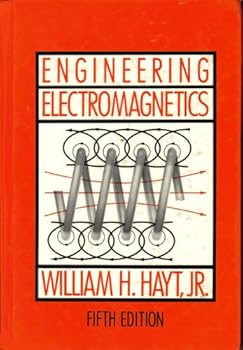Engineering Electromagnetics
(Part of the Electrical and Electronic Engineering Series Series)
Select Format
Select Condition 
Book Overview
Now in its Seventh Edition, Bill Hayt and John Buck's Engineering Electromagnetics is a classic book that has been updated for electromagnetics today. This widely respected book stresses fundamentals... This description may be from another edition of this product.
Format:Hardcover
Language:English
ISBN:0070274061
ISBN13:9780070274068
Release Date:January 1988
Publisher:McGraw-Hill Companies
Length:472 Pages
Weight:1.75 lbs.
Customer Reviews
4 ratings
Classic Text on E & M
Published by Thriftbooks.com User , 15 years ago
Read this book from cover-to-cover a few years ago to brush up on E & M theory. I have always been partial to Hayt as an author of classic EE titles and this book did not disappoint. The prose was clean, the development logical and the treatment adequately thorough for an undergrad text. For those who find their first class in E & M a little daunting, I would strongly recommend the little book: "Div, Grad, Curl and All That" by H.M. Shey. This informal text covers all of the vector calculus essential to basic E & M theory with lots of worked examples and problems with solutions. My advice is to bone up on vector calculus first -- it makes E & M theory much more accessible.
Excellent book for beginners
Published by Thriftbooks.com User , 20 years ago
This is the best book I ever found on this topic. Its assumes you a beginner and takes you to the engineering level. William Hayt has an outstanding way of communication with the reader. All you require is concentration and imagination power. The book is well structured. First four chapters are specially of interest for beginners. I will strongly recommend this book to those who are interested in telecommunications.The reason of giving four stars is that it does not give answers to the questions in the book(I read 6th edition), you have to get them from web site(mentioned in the book). The only difference between 5th and 6th edition is of drill problems and end of chapter problems(Theory is same). 6th edition contains an extra chapter on antenna.As a conclusion, I strongly recommend this book to beginners.
The most accessible Electromagnetics text yet
Published by Thriftbooks.com User , 21 years ago
Electromagnetics is a subject that can be made as interesting or as dull as possible by a. the instructor and b. the book.I was lucky on both counts. And the book I chose was this (in addition to John Kraus).You must love William Hayt. He is one of the liveliest authors in electrical engineering. The way the text is presented, the examples, the problems solved and the like will remove the "ELECTROMAGNETICS IS TOUGH..." myth completely.This may not be the best book around (for the purists), but it is certainly the most accessible!
Excellent Introduction to Engineering Electromagnetics
Published by Thriftbooks.com User , 24 years ago
I used the book for a junior level course in Engineering Electromagnetics at UCLA in early 1971. The course was taught very well in terms of concepts by a Plasma Physicist who held a professorship in the School of Engineering and Applied Science, UCLA.It is my belief this is an excellent book for teaching motivated students and for learning the subject in depth at the outset. Though it is not in my view a good reference book as a few others at roughly the same level or higher for the purpose of browsing to pick up key ideas and concepts with engineering applications (e.g., Krause's excellent book on Electromagnetics), yet it is very well organized in that all concepts presented are built up one upon another in a closely connected, coherent and systematic fashion analytically with vector methods, and difficult physical ideas are often pictorially illustrated with diagrams in color. This is true in both the older edition and the 5th edition (1989), being that there are not really a lot of significant differences between the editions.The book starts with vector calculus and basic underlying ideas in electrostatics (Coulomb's Law), and goes onto Gauss's Law, energy and potential, electric currents and conduction, electric fields, capacitance, dielectric materials and other related topics (e.g., refraction). It then progresses into steady magnetic field, inductance and eventually toward Maxwell's equations and engineering applications. There is no lack of mathematical methods which are treated as needed and sufficient in depth all throughout the book, e.g., divergence theorem, Laplace's and Poisson's equations and related boundary value problems. The book ends with uniform plane waves (as an approximate model of the propagating EM wave), and discusses transmission line models which then lead to applications. The only regrettable aspect is the brief treatment of antennas as the subject is barely touched upon as part of EM radiation, and the only tangible real-world example I could recall was a dipole antenna.As a summary, this is a well written book, albeit a somewhat introductory text designed for Electrical Engineering juniors and seniors by a seasoned Purdue professor. It will help tremendously if the instructor is good at explaining concepts and illustrating them (as was mine in 1971). I must say I love the subject because I had such good instruction and learning experiences based on this book which I had to refer to many times over the years.





